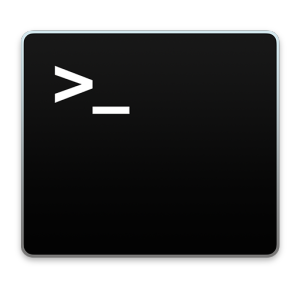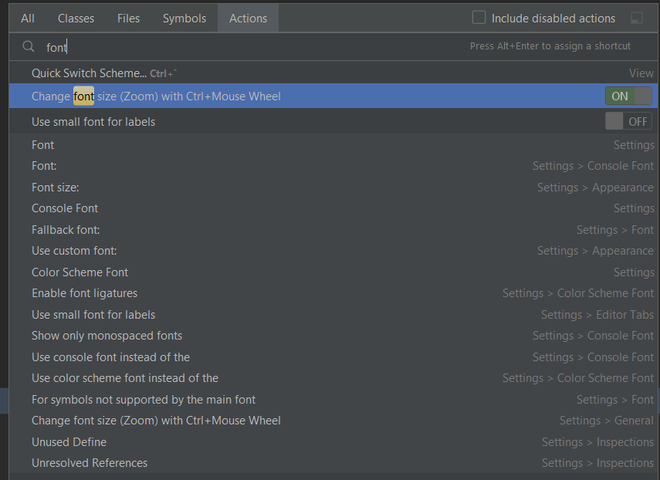
- #How to change font size on mac terminal for mac#
- #How to change font size on mac terminal install#
- #How to change font size on mac terminal code#
- #How to change font size on mac terminal plus#
- #How to change font size on mac terminal windows#
Obviously the “–geometry” parameter does what I want. However, it shows me that we can pass parameter(s) to do such thing, it’s much easier.įirst, I run “terminator –help” to get all the supported parameters.
#How to change font size on mac terminal code#
This article provides a way to set the size of the terminator window by changing the python code directly, which is also complicated. Refer method above is sort of complicated, I found a simpler way to do the same thing and more: a method can not only set the size of the terminator window, but also the initial position in the monitor, inspired by here. This line “size = 900, 600” is where you set the default window size. My configuration file, for instance, looks like this: 1Įnabled_plugins = CustomCommandsMenu, InactivityWatch, ActivityWatch, TerminalShot, LaunchpadCodeURLHandler, LaunchpadBugURLHandler You only need to add a line within the sub-section named ]] belonging to the ] section. Open the file “~/.config/terminator/config” with your favorite editor. Be default, the window size is small, so it’s useful to set its default size larger.
#How to change font size on mac terminal windows#
It has the multiple windows terminals capability. # rprojroot 1.3-2 cran stats * 3.5.Terminator is an alternative of gnome-terminal.

# colorout * 1.2-0 Github compiler 3.5.1 local # backports 1.1.2 cran base * 3.5.1 local # date # Packages - # package * version date source # version R version 3.5.1 Patched ( r75439) Reproducibility # Session info - # setting value So, if you’re regularly using directories on Lustre that have lots of files in them, and your “ls” command it taking too long, we recommend using “ls –color=none”. With these options, the ls command needs to iterate through each file in the directory, and query the lustre server for each and every file to retrieve information about the file in order to determine what color to display. One thing we (and others) have found is that, for a directory on a Lustre filesystem (/dcl01 or /dcl02), using “ls –colors=auto” or “ls -al” on a directory with lots (thousands+) of files in it can be super slow. You mention setting colors for the ls output, which is great. We got this note from Mark Miller, admin of JHPCE: I use the same LS_COLORS now on my Mac too, but you don’t need to. # that way I can use the same config file =) # then change the aliast to use gls instead of ls
#How to change font size on mac terminal for mac#
Mac extra lines: # Uncomment below for Mac and comment the two previous commands # that tool does not specify the colors, which I did by looking manually at # used BSD pattern ExGxFxDxB圎gEdxbxgxhxd on The following lines of my ~/.bashrc file include some old history of the colors and how I use to have other options.


#How to change font size on mac terminal install#
This goes in hand with the ls -color=auto shortcut to make sure that the colors are used (Mac: you might need brew install coreutils as described in this blog post). For example, do you want directories to be shown in blue and/or bold font while executable files are shown in red. You can change the colors of your terminal. Where ~/.inputrc file has the following contents: #Page up/page downĪs an added benefit, the up and down arrows will now have this improved behavior when you run R inside a terminal, although it’s limited to your current R history: actually, I guess that you could change your. Next I use the up arrow, and it only finds for me commands that start with cd /, including this long one.ĭid you like this? Well, add the following code to your ~/.bashrc file # Auto-complete command from history So I type cd / in the terminal window (without hitting enter). Lets say that I want to change directory to one of my recent projects. So far, this is the same as the default up arrow behavior. If you use the up arrow, you can navigate your command history. Lets say that you just requested a compute node with qrsh and you have an empty line. The following changes make it so that the up arrow searches only commands that start with exactly the letters you had already typed. Normally, the up and down arrow let you select previous commands from your bash history (up) or select one of your latest commands (down, after having used up).
#How to change font size on mac terminal plus#
The next change will save you a lot of time! Plus it goes nicely with the bash history changes we just made.


 0 kommentar(er)
0 kommentar(er)
